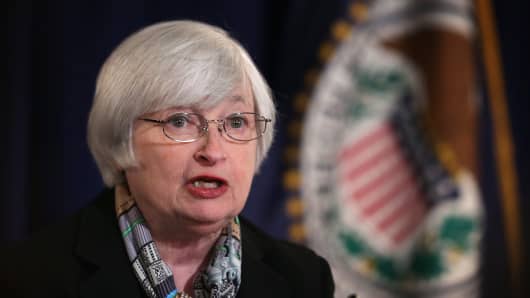One economist recently suggested that the Federal Reserve's first step to raise interest rates, whether in June, or beyond, would be to lift rates even more gently than the market currently expects – perhaps 0.125 percent vs. the 0.25 percent expected.
I don't think the Fed will raise rates at all in 2015, owing to a weakening world economy and a strengthening U.S. dollar. However, if the Fed believes the normalization process should begin this year, I would suggest an even more modest proposal that might allow the central bank to gently test the market and economic waters.
Read MoreIs a June rate hike coming? Mixed messages...
The federal-funds rate, the rate controlled by the Fed, but which banks charge one another for overnight loans, is currently pegged between zero and 0.25 percent. The effective funds rate, which is the actual cost of overnight loans, is usually about 0.125 percent, although it fluctuates from day to day between its upper and lower bound (the lower bound being zero).
The Fed, if it so desired could lift the "floor" of the fed-funds target to the current effective rate of 0.125 percent, while leaving the "ceiling" at 0.25 percent.
The snugging of policy would represent a first step in normalization but would allow the Fed the luxury of monitoring the economy and market's response to that move toward normalization.
If all goes well, the Fed could, at its subsequent meeting, raise the ceiling by an eighth of a percent to 0.375 percent, effectively moving the fed-funds target by a quarter percent over two meetings.
Read MoreSummers: Why the Fed should not raise rates
This two-step process could be continued over time, giving the market, at home and abroad, plenty of time to adjust to the normalization policy: Raise the floor, then raise the ceiling, until policy rates are moved back toward normal.
If the economy and markets react violently to the two-step, the Fed could pause, but would have gotten the floor rate off the zero bound.
By capping the ceiling, the Fed could minimize the impact on the real economy and allow key rates, like mortgage rates, to rise more slowly than they would under a typical tightening cycle and, thus, allow a long-awaited recovery in housing, which is just starting to move, as family formations re-accelerate.
It is a modest proposal, but maybe one worth thinking about at a sensitive juncture in the world's asynchronous recovery.
Commentary by Ron Insana, a CNBC and MSNBC contributor and the author of four books on Wall Street. He also editor of "Insana's Market Intellgence," available at Marketfy.com. He delivers a daily podcast, "Insana Insights," and a long-form weekly version, both available on iTunes and at roninsana.com. Follow him on Twitter @rinsana.



